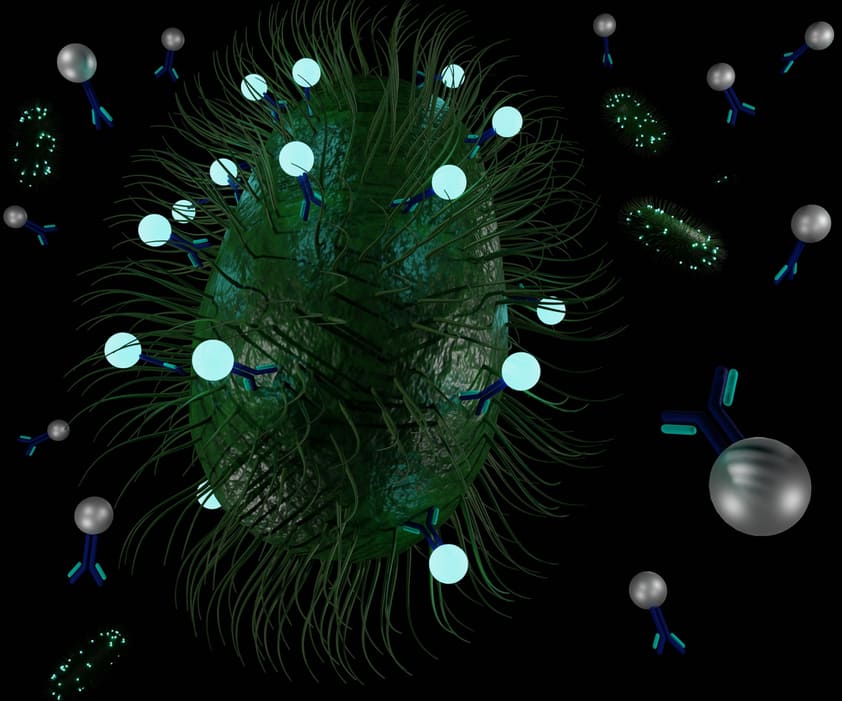Magnetic bead-based fluorescent immunoassays can detect and measure single or multiple analytes, such as certain proteins, present in one sample. The technology uses fluorescent magnetic beads, such as StrepTalontm or Luminex® beads, and detection antibodies to detect multiple analytes, and therefore answer multiple questions, simultaneously. So how do they work?
How do fluorescent magnetic bead-based assays work?
Magnetic bead fluorescent assays, such as those using Luminex® beads, generally follow these steps:- Carboxyl-functionalized magnetic beads are covalently joined to a specific ‘capture’ antibody. The capture antibody corresponds to a specific target analyte protein.
- Once the capture antibodies have bound to the target analyte, unbound materials are washed away.
- Detection antibodies that are specific to the analytes of interest and labeled with are added.
- The reporter, e.g. streptavidin-phycoerythrin or alkaline streptavidin phosphatase, is added, and binds to the detection antibodies. The detection antibodies are now said to be biotinylated.
- The sample is incubated with the detection antibodies bound to the reporter, and forms an antibody-antigen sandwich.
- The tubes are placed in a magnetic separator for 2 min, to gather the magnetic beads, and the supernatant is removed.
- If the analyte is present in the same, the reporter-detection antibody complex loses a phosphate group from the phosphate substrate.
- A fluorometer is used to read the resultant fluorescent signal.
- Beads can be joined to different capture antibodies, each with a distinct fluorescence signature, enabling the simultaneous assay of multiple target analytes.
How are fluorescent magnetic beads analyzed?
Fluorescent magnetic beads can be read using fluorometers or specific magnetic analyzers, rather than a Luminex® bead flow-based analyzer. Magnetic analyzers use two LED light sources with distinct spectra to illuminate the beads. Similar to a Luminex® bead analysis, one LED detects the presence of the analyte and the other determines the reporter-derived signal size.
How can I wash fluorescent magnetic beads?
Washing magnetic beads is an essential step in an assay to remove unbound materials. The easiest way to separate your magnetic beads from solution is with a magnetic separator device.
Benefits of Fluorescent Magnetic Beads Assays
Functionalized magnetic beads can be used as sensitive yet simple to use immunosensing probes for detecting a wide range of analytes. Magnetic bead-based fluorescence immunoassays have the following benefits compared to non-magnetic bead-based techniques:
- No need for filtration steps, unlike other methods such as assays using Luminex beads
- One-step, wash-free assays possible
- Ability to be used in point-of-care settings
- No need for centrifugal steps
- Significantly improve the sensitivity of immunoassays for biomarker detection
Applications of Fluorescent Magnetic Beads
Fluorescent magnetic beads can be conjugated to antibodies, DNA, proteins and peptides, and have a range of applications, from protein expression profiling to molecular diagnostics. Other uses include:
- Gene expression profiling
- Growth factor, cytokine and chemokine detection
- Human Leukocyte Antigen (HLA) testing
- Novel inflammation marker detection
- Toxin detection
- Automated point of care testing
- Serological assays
Newer multiplex immunoassay techniques
Off-label multiplex immunoassays, such as arrayed imaging reflectometry (AIR) and suspension microsphere immunoassays, are becoming more common. Label-free multiplex assays are even simpler and easier to use, and these new biosensing technologies have the potential to offer more sensitive and selective detection of target molecules. Read our articles on the different types of immunoassays and immunomagnetic beads to find out more.
Related news
- Limitations and perspectives of Chemiluminescent immunoassay (CLIA)
- Spin Column
- CLIA-label protein conjugation





